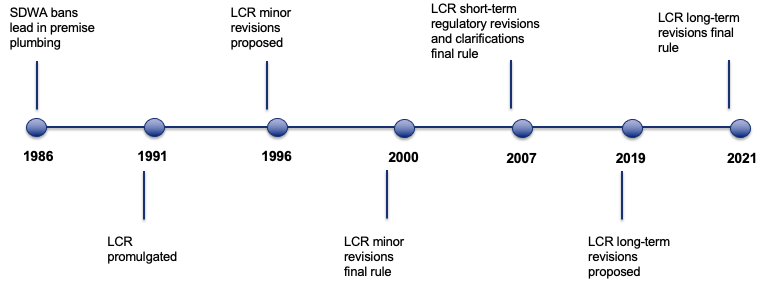The country is a step closer to addressing the longstanding issue of lead in the country’s drinking water with the bipartisan infrastructure bill that Congress advanced last week allocating US$15 billion for lead pipe remediation. Knocked down from US$45 billion, the approved funding for removing lead pipes from drinking water sources is US$17 billion short of Bluefield’s estimate of the US$32 + billion needed to get the job done. Despite this shortfall, the allocated US15 billion is this country’s largest investment in clean water to date.
Bluefield estimates some 6.1 million lead service lines (LSLs) remain in the ground across the country, serving between 15 million and 22 million people. The proposed updates to the Lead and Copper Rule (LCR) adopt a more proactive and accelerative stance around lead removal, with a greater emphasis on public information in school and childcare facilities and accurate accounting of the existing lead pipes in the ground.

Source: Bluefield Research
And of course, before the remainder of this network of lead can be fully removed, it must first be fully identified and located, and, in many cases, prioritized and coordinated with other construction efforts, which creates a massive challenge for the water industry. And there is a chain of information around lead sampling, reporting, notifications, and pitcher/filter distribution that needs to be managed as well.
The largest problem areas for LSLs are known to be in the Midwest and Northeast regions of the country, where infrastructure is generally older in age. There is unfortunately a wide range in the availability and fidelity of record keeping around lead that is utility-specific, and what level of scrutiny it has dealt with by state-led efforts to this point. In some cases, utilities don’t have a full picture of the pipe materials beneath the ground in the area they serve, particularly when it comes to the private side of the service line that belongs to the property owner.
Illinois provides a good example of this challenge. The state is estimated to have the largest number of lead service lines in the country, with over 675,000 known to be lead still in the ground and another 379,000 that are copper with lead solder, but there are likely many more that have yet to be identified. According to the Illinois EPA, of the state’s approximately 3.8 million pipes, over 1.1 million of them, nearly 30%, are of a currently unknown material, and over 775,000 of those have the possibility of being lead based on the currently known records.
This is an area where digital solutions can help. Predictive analytics capabilities can help utilities better understand where their lead pipes are concentrated using disparate data sources, as well as manage and coordinate information across stakeholders, and allow better resource allocation in removal.
A recent example of this is Denver Water, which announced an initiative last year to remove all of its lead service lines—estimated between 64,000 and 84,000—within 15 years, and ended up exceeding its own 2020 goal by removing 5,200 LSLs. Denver Water has used geolocational software to prioritize its digging efforts as well as to coordinate information around the distribution of water filters and sampling information for customers. The program is a notable recent (and ongoing) success story in LCR projects and we expect many will seek to emulate key aspects of it as regulatory updates come into force. And in turn, we expect to see increased development and roll-out of digital solutions across diversified engineering firms and software pure-plays alike.
We’re excited to see what comes next as federal infrastructure negotiations crawl closer into focus. Regardless of the outcome, Bluefield is committed to helping stakeholders across the water industry better understand and navigate the market and regulatory landscape in water quality issues like LCR.

